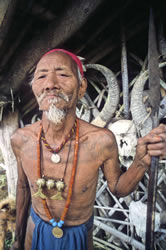
- Remains of Skulls arranged in morungs
Inhibiting the Longding District of Arunachal Pradesh, the indigenous Wanchos, (originally related to the Naga tribes) were follower of animism since the time immemorial. Head-hunting practices were crucial part of strong tradition among the tribe in the past. This practices was not purely a religious believe, yet it carried behind it the religious sanctions. Interestingly, there was remarkable belief in the magical efficacy of human head as it was believed to increase the yield of cultivated land. Therefore, belief in the magical powers of human heads, particularly in connection with the fertility cult, was also considered to be one of the reason behind this practice. Different stories regarding the origin of head-hunting can be find among this tribe. However, the basic reason behind the custom of head-hunting was the internal feuds among various Chiefs due to various reasons. In addition to the expression of their manliness and power the head-hunting expeditions were also resorted for more serious matters such as encroachment on territories by rival villages.
Generally, the causes for head-hunting arose between the two chiefs and their subjects automatically got involved in it. The expedition was undertaken when the prediction was favorable (naantak - a) and head were taken indiscriminately. However, under no circumstances, a commoner could take the head of a chief. After the heads were brought to the village, the flesh was allowed to decompose and preserved in the morungs or 'Panu' (a traditional house specially constructed for the grownups commoners near the house of the Chief). Only grownups boys (after completion of ceremony) were allowed to enter, whereas girls were strictly forbidden.

- Old warior with Tattoo on His chest and face
A ceremony was held after bringing the heads to the village in which the warriors were tattooed on face and chest as a mark of bravery. Such tattoo usually remarks the number of enemy heads they bring with them. Thus, the tattoo symbolize them as 'Nawmai' (Warriors). In rituals which was performed after expedition (called 'Zantang'), the rivals heads were offered rice-beer and pieces of ginger. The man who hunts head is no longer considered as boy and thus assist in council of village Chief. Moreover, he also earns top positions in morungs among fellow-mates. The rival heads were usually handed to the chief, who confers the right of decoration by tattoo and follows with big fat communal feast. The chief’s house were now filled with numerous trophies of the chase and memorials of feasts; while 'paanu' was dedicated to the collection of memories of ferocity and vengeance i.e. thousands of human skulls arranged in shelves. It also includes the records of recent achievements, and basket full of fragments of skulls, the memorials of the bloody deeds of their forefathers and heads of exceptionally large animals and reptiles. Among them the head-hunting raids of the past and human head had formed the central motif of their traditional wood carving, ornaments (including beads making) and sculptures. Nevertheless, with the introduction of Christianity by Naga Missionaries in this tensed region, the headhunting practices are not seen till date.